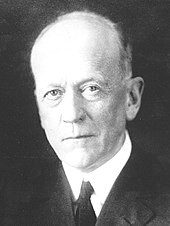Charles Walcott
Charles Doolittle Walcott (born March 31, 1850 in New York Mills , Oneida County , New York , † February 9, 1927 in Washington, DC ) was an American paleontologist who was particularly concerned with fossils of the Cambrian .
Live and act
Walcott started early with the collecting of minerals , fossils and bird eggs. Leaving school with no graduation at the age of 18, he turned his passion for fossils into a profession by trading with them. He met Louis Agassiz from Harvard University and turned to paleontology through his influence. First he was assistant to the geologist of the state of New York, James Hall , and from 1879 worked for the United States Geological Survey . Walcott was director of this federal agency from 1894 to 1907 and then successor to Samuel Pierpont Langley as Secretary of the Smithsonian Institution , which he remained until his death. After meeting Andrew Carnegie in 1902 , he was one of the founders of the Carnegie Institution in Washington.
In 1909 Walcott discovered the "Phyllopod bed" ( Burgess slate in the narrower sense) in the Cambrian sedimentary rocks of the mountains north of the valley of the Kicking Horse River near the village of Field (British Columbia, Canada). From 1910 to 1924 he kept coming back to this world-famous conservatory and collected over 65,000 fossils. He was often supported by family members on his excursions. He was a member of the American Association for the Advancement of Science (of which he was president in 1923), the National Academy of Sciences (1896), of which he was president from 1917 to 1923 and of which he received the Mary Clark Thompson Medal in 1921, and the American Academy of Arts and Sciences (1899). In 1909 he received an honorary doctorate from the University of Cambridge . In 1901 he was President of the Geological Society of America and in 1913 President of the Paleontological Society . In 1918 he became a corresponding member and in 1919 a foreign member of the Académie des sciences .
In 1872 he married Lura Ann Rust, the daughter of a farmer, on whose land he discovered an important trilobite site (Walcott Rust quarry near Russia in New York, limestone of the Upper Ordovician). She died in 1876. In 1888 he married Helena Breese Stevens, with whom he had four children. She died in a railway accident in 1911. In 1914 he married Mary Morris Vaux, who also worked as a painter and accompanied him on his travels. Walcott is buried in Rock Creek Cemetery, Washington DC.
Walcott became known to a wider audience through Stephen Jay Gould ( Wonderful Life 1989).
A mountain peak on Mount Burgess in Canada is named after him. Same goes for Mount Walcott , Walcott Glacier , Walcott North Stream , Walcott South Stream , Walcott Bay, and Walcott Lake in Antarctica. The National Academy of Sciences awards the Charles Doolittle Walcott Medal every five years for outstanding palaeontological work on the Cambrian and Precambrian. In 1912 he became an honorary member of the Paleontological Society .
Fonts

- Cambrian Geology and Paleontology , 5 volumes. Smithsonian Institution, 1910-1928, Volume 1 - Internet Archive
- Geology of the Eureka District, Nevada, with an Atlas . In: Monographs US Geological Survey , No. 20, 1884
- Paleontology of the Eureka District . In: Monographs of the US Geological Survey , No. 8, 1884, archive.org
- Cambrians faunas of North America . In: Bulletin US Geological Survey , 1884
- The Fauna of the Lower Cambrian or Olenellus Zone . Washington DC 1890
- Correlation Papers on the Cambrian . In: Bulletin US Geological Survey , No. 81, 1890, Washington DC
- Fossil Medusae . In: Monographs US Geological Survey , No. 30, 1898, archive.org
- Cambrian Brachiopoda . 2 volumes. Government Printing Office, Washington DC 1912, archive.org
- Cambrian Fauna of India . Washington DC 1905
- Cambrian Faunas of China . In: Proc. of the United States National Museum , Volume 30, 1905
- Walcott, Charles Doolittle . In: Encyclopædia Britannica . 11th edition. tape 28 : Vetch - Zymotic Diseases . London 1911, p. 252 (English, full text [ Wikisource ]).
literature
- Ellis Yochelson : Charles Doolittle Walcott. Paleontologist , Kent State University Press 1998
Web links
- Ellis Yochelson: biography. (PDF) GSA Today
Individual evidence
- ^ List of former members since 1666: Letter W. Académie des sciences, accessed on March 13, 2020 (French).
- ^ Paläontologische Zeitschrift 1, Issue 1, March 1914, p. 65
| personal data | |
|---|---|
| SURNAME | Walcott, Charles |
| ALTERNATIVE NAMES | Walcott, Charles Doolittle |
| BRIEF DESCRIPTION | American paleontologist |
| DATE OF BIRTH | March 31, 1850 |
| PLACE OF BIRTH | New York Mills , New York |
| DATE OF DEATH | February 9, 1927 |
| Place of death | Washington, DC |

